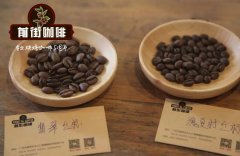Flavor characteristics of Genesis microbatches in Costa Rica and description of the processing plant
[Genesis Micro batch of Costa Rica]
Country: Costa Rica
Region: Western Valley
Processing plant: Finca Genesis Genesis Micro batch processing Plant
Altitude: 1700 m
Variety: Kaddura / Kaduai
Level: SHB
Treatment: insolation
Introduction of the treatment plant
Piedades Alajuela is located in the well-known western valley producing areas, planting about 1700 meters above sea level, mainly to grow Kaddura, Kaduai. With the help of the unique local climate, Genesis processing plant produced this micro-batch of sun-dried coffee beans, which has rich fruit aroma and good cleanliness.
Genesis is one of the earliest microbatch processing plants in Costa Rica and is now run by Oscar Mendes and his wife Olga. They have been producing coffee for many years, and the couple are the leaders of their community and share a lot of experience and knowledge with other farmers. Oscar and Olga buy coffee cherries from farmers in the area and process raw coffee beans at Genesis. Producers can simply pay for processing services, or they can sell their cherries to a processing plant, where the coffee processed will attach the name of the farm to the coffee for recognition.
Introduction of origin
The western valley is one of the seven major producing areas of Costa Rica, known as Valle Occidental. The harvest time in the western valley is from November to March of the next year, which is regarded as a long harvest area, with a fruity flavor and a nutty almond flavor. Western valley beans, the acid is not as bright as Tarazu, the taste is more stable, but the slightly lower temperature of coffee flavor, it is amazing, because the flavor changes continuously, in terms of the pursuit of taste, she is not amazing, but rather like [look good, medium drink] type.
Rich volcanic soil, sufficient sunshine, with an annual average relative humidity of 81%, abundant rainfall and an average annual temperature of 21.50 ℃, make crops grow luxuriantly in this area, and are also conducive to the cultivation of high-quality coffee at high altitude. In addition, the western valley region has a distinct dry and wet season, and when the coffee harvest season begins, it will enter the dry season, which means that the area has sufficient sunshine for washing and sunbathing. This advantage is seldom found in other producing areas in the country (almost all other famous producing areas in Costa Rica are machine-dried). The average altitude is 1000 to 1600 meters above sea level.
The coffee industry in Costa Rica started early, with the first batch of coffee shipped to Colombia and Chile as early as 1820. In 1854, an exporter, with the assistance of William Lyon, captain of the British merchant ship the Sovereign, successfully shipped 100 pounds of coffee to London, which became popular and was praised by British aristocrats as the "golden bean" from Costa Rica.
The overall balance is high, the sweetness is good, and the taste is very clean. With aromas of fermented wine, spices and caramel, the palate is sour and then sweet, with citrus and grapefruit flavors, juicy and refreshing berry finish.

Important Notice :
前街咖啡 FrontStreet Coffee has moved to new addredd:
FrontStreet Coffee Address: 315,Donghua East Road,GuangZhou
Tel:020 38364473
- Prev

Ethiopian coffee producing area introduction The difference between red cherry coffee and Kocher coffee and
There are eight major coffee producing areas in Ethiopia: Lekempti, Limu, Illubabor, Djimmah, Harar, Teppi/Bebeka, Sidamo and Yirgacheffe. Yegashefi is a small town in Ethiopia with an altitude of 1700-2100 meters. It is one of the highest coffee producing areas in the world and synonymous with Ethiopian fine coffee. Lake Turkana, Argentina
- Next

Is there any difference between Rose Summer Village Red Standard Rose Summer Coffee and Emerald Manor Red Standard Rose Summer Coffee?
Professional coffee knowledge exchange more coffee bean information Please follow the coffee workshop (Wechat official account cafe_style) Rose Summer Coffee has been quite popular in recent years, so what is the difference between the red sign of Rose Village and the red sign of Jadeite Manor? | Jadeite Manor is located in the Pokuit producing area of Boquete, to the east of Mount Baru, and is the oldest in Panama.
Related
- Detailed explanation of Jadeite planting Land in Panamanian Jadeite Manor introduction to the grading system of Jadeite competitive bidding, Red bid, Green bid and Rose Summer
- Story of Coffee planting in Brenka region of Costa Rica Stonehenge Manor anaerobic heavy honey treatment of flavor mouth
- What's on the barrel of Blue Mountain Coffee beans?
- Can American coffee also pull flowers? How to use hot American style to pull out a good-looking pattern?
- Can you make a cold extract with coffee beans? What is the right proportion for cold-extracted coffee formula?
- Indonesian PWN Gold Mandrine Coffee Origin Features Flavor How to Chong? Mandolin coffee is American.
- A brief introduction to the flavor characteristics of Brazilian yellow bourbon coffee beans
- What is the effect of different water quality on the flavor of cold-extracted coffee? What kind of water is best for brewing coffee?
- Why do you think of Rose Summer whenever you mention Panamanian coffee?
- Introduction to the characteristics of authentic blue mountain coffee bean producing areas? What is the CIB Coffee Authority in Jamaica?

